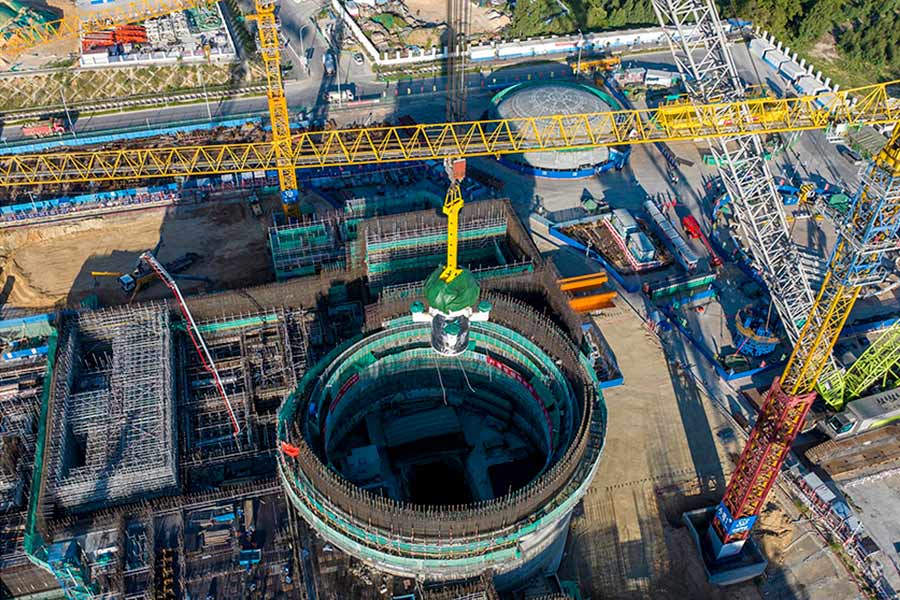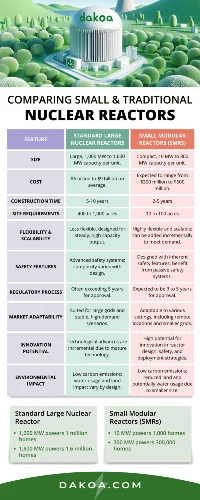Riding the Waves of Nuclear Innovation: Small Modular Reactors Spark a New Energy Era
Nestled in the frigid waters off the Siberian coast, the Akademik Lomonosov basks as a beacon of modern nuclear capabilities, not far from Alaska. This pioneering floating nuclear power plant has been energizing approximately 200,000 people for the last four years, leveraging what’s known as small modular reactor (SMR) technology.
SMRs, renowned for their compact size and cost-effective construction, are propelling not just ships below the ocean’s surface — dozens of US submarines are powered by these reactors — but also a burgeoning nuclear revival as the globe seeks urgent alternatives to fossil fuels. In the international arena, powerhouses like the US, Russia, and China are vying for supremacy in the SMR market.

The American Drive for Nuclear Innovation
Amidst fierce competition, particularly from China’s leading position in nuclear technology and Russia’s near-monopoly on SMR fuel production, the United States is making significant strides to claim its stake in this emerging market. The Biden administration, together with American firms, is injecting billions into the development of SMRs, aiming to pivot from being a follower in the renewable sector to a leader in nuclear tech.
Despite the setbacks in wind and solar sectors, which China overwhelmingly dominates, the US is determined not to repeat history. “There’s definitely a huge race on. China and Russia have more agreements to build all sorts of reactors overseas than the US does. That’s what the US needs to catch up on,” comments Josh Freed of Third Way, to address the urgency with which the US is escalating its efforts to deploy these technologies globally.
“Our nuclear vendors are competing against cheap, natural gas in the US,” and abroad, they’re “competing against authoritarian-backed entities who are throwing in a lot of political pressure and package deals.”

Global Ambitions and Environmental Imperatives
As nations intensify their efforts to decarbonize, transitioning to more sustainable energy systems becomes imperative. SMRs offer a promising solution with their smaller footprint and adaptability, capable of being assembled like a “nuclear plant flatpack” across diverse locales. This shift is crucial as traditional nuclear power sees a resurgence, with the International Energy Agency suggesting a potential doubling of nuclear capacity by 2050 to meet climate targets.
“The organization predicts nuclear power generation globally will reach an all-time high in 2025,” according to an IEA statement, sparked by the reactivation of several Japanese reactors and new projects across Asia and Europe. This resurgence is critical as the world grapples with the increasing frequency of extreme weather events and the ongoing challenges posed by renewable energy sources.
The US’s Strategic Play in International Markets
With an eye on reducing dependency on adversarial powers like Russia, the US is actively marketing its SMR technology to nations new to nuclear power, emphasizing safety and reliability. The US Export-Import Bank and the International Development Finance Corporation have already committed significant funding to support SMR projects abroad, such as those in Poland by GE Hitachi Nuclear Energy.
Additionally, the US is making inroads into Southeast Asia and Eastern Europe, regions eager to diversify their energy sources away from traditional powerhouses like China and Russia.
“Countries recognize the risks of working with authoritarian-backed suppliers and seek partners that will strengthen their independence and their energy security,” states Kirsten Cutler from the US State Department.
Money & The Road Ahead
However, the economic viability of SMRs is concerning. To put it simply, it’s super expensive!
High construction costs and economic factors have impacted projects like Oregon-based NuScale’s Idaho demonstration, which recently saw its costs double. “It makes a big difference in the marketing if the US is out there making it happen,” explains John Parsons of MIT, stressing the importance of successful deployment in boosting international confidence in SMR technology.
8 Things You May Find Interesting On This Topic
Historical Context and Recent Developments
- Four-Year Milestone: Russia’s Akademik Lomonosov, the world’s first floating nuclear power plant, has been operational off the Siberian coast near Alaska for four years, providing energy to around 200,000 people.
- Historical Disasters: The Chernobyl disaster in 1986 and Fukushima disaster in 2011 had profound impacts on public perception and development of nuclear power globally, leading to a significant dip in new nuclear projects.
Technological Insights
- Energy Output: Small Modular Reactors (SMRs) typically produce about a third of the electricity compared to traditional nuclear plants, posing both challenges and opportunities in energy planning and management.
- Modular Construction: SMRs can be assembled from small, manageable parts on-site, akin to a “nuclear plant flatpack,” which simplifies the logistics and potentially reduces construction time and cost.
Global Energy Dynamics
- Renewable Energy Statistics: Wind and solar energy currently provide at least 12% of global power, with their contribution exceeding that of fossil fuels in regions like the European Union.
- International Energy Agency (IEA) Forecast: The IEA projects a necessary increase in nuclear power, advocating for a doubling by 2050 to meet global decarbonization goals.
US Strategic Initiatives
More To Discover
- Siemens Energy’s Wind Turbine Woes Reflect Challenges in Germany’s Energy Shift
- Enviva In Crisis: Dissecting the Inevitable Collapse of Biomass Energy’s Biggest Player
- Sustainable Circuit Boards That Turn to ‘Jelly’ for Effortless Recycling
- Looking To Transform Offshore Energy? Remove The Turbines For Towerless Power
- Federal Funding and Programs: The Biden administration, through initiatives like the FIRST program, is not only investing in the technological development of SMRs but also facilitating international cooperation and adoption by offering a comprehensive suite of tools including workshops, engineering, and feasibility studies.
- Financial Commitments: The US government, through its Export-Import Bank and International Development Finance Corporation, has earmarked significant funds totaling billions of dollars to promote SMR projects internationally, such as in Poland with reactors designed by GE Hitachi Nuclear Energy.
As the US continues to advocate for nuclear energy’s role in sustainable development, it faces the dual challenge of proving SMRs’ economic benefits while navigating the complex geopolitical landscape of global energy politics. With concerted effort and strategic partnerships, the US aims to not only enhance its energy independence but also position itself as a reliable and innovative leader in the nuclear renaissance.
The journey of SMRs from novel concept to global solution epitomizes the broader shift towards a more sustainable and secure energy future, emphasizing the critical role of innovation in addressing the pressing challenges of climate change.






















